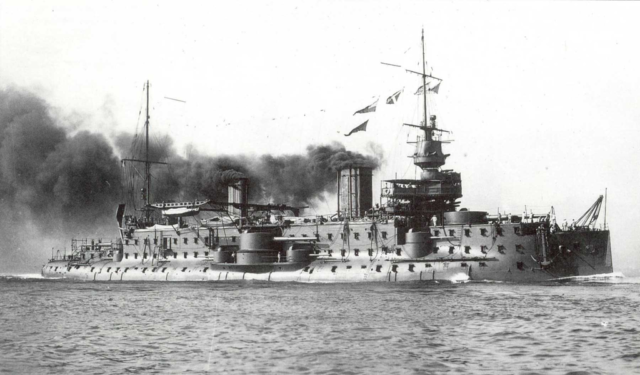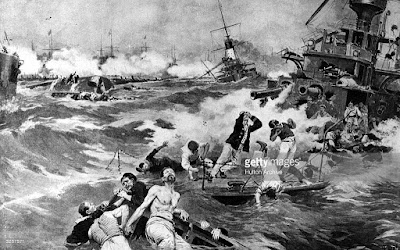I was giving a book in 1975 that my Dad bought me called "Sea Battles of the 20th Century", The battle of the Tsushima Straits was the first battle listed and this image I remembered
Pre-dreadnought battleships were sea-going battleships built between the mid- to late 1880s and 1905, before the launch of HMS Dreadnought.Pre-dreadnoughts replaced the ironclad battleships of the 1870s and 1880s. Built from steel, and protected by hardened steel armour, pre-dreadnought battleships carried a main battery of very heavy guns in barbettes (open or with armored gunhouses) supported by one or more secondary batteries of lighter weapons. They were powered by coal-fuelled triple-expansion steam engines.
In contrast to the chaotic development of ironclad warships in preceding decades, the 1890s saw navies worldwide start to build battleships to a common design as dozens of ships essentially followed the design of the British Majestic class. The similarity in appearance of battleships in the 1890s was underlined by the increasing number of ships being built. New naval powers such as Germany, Japan, the United States, and – to a lesser extent – Italy and Austria-Hungary, began to establish themselves with fleets of pre-dreadnoughts, while the navies of Britain, France, and Russia expanded to meet these new threats. The decisive clash of pre-dreadnought fleets was between the Imperial Russian Navy and the Imperial Japanese Navy during the Battle of Tsushima on 27 May 1905These battleships were abruptly made obsolete by the arrival of HMS Dreadnought in 1906. Dreadnought followed the trend in battleship design to heavier, longer-ranged guns by adopting an "all-big-gun" armament scheme of ten 12-inch guns. Her innovative steam turbine engines also made her faster. The existing pre-dreadnoughts were decisively outclassed, and new and more powerful battleships were from then on known as dreadnoughts while the ships that had been laid down before were designated pre-dreadnoughts.
In the seventeenth and eighteenth centuries,
navies were very important. The maritime powers of Europe, particularly
England, France, Spain, the Netherlands, and Portugal, relied upon them
to protect trade routes and overseas colonies. Warships were the most
powerful weapons a state could possess. They were mostly divided into
frigates, built for speed and agility, and ships of the line, designed
for battle.
With
the invention of the steam engine in the eighteenth-century naval
warfare changed radically. The propeller greatly enhanced the speed and
maneuverability of ships. Steam-powered vessels did not have to rely on
the sail, and so engineers could think more of weaponry and protective
armour. This made armoured vessels – ironclads – possible.
Carnot started an arms race between the French and British. By the end of Napoleon III’s reign, the French Navy had 38 steam-powered wooden battleships, 28 of which were converted sail vessels. In response, the British built 18 news ships and converted 41 others.
During the Crimean War (1853 – 1856) The British and French were allies against Russia, and their navies co-operated in engagements against the Russian Black Sea Fleet and coastal targets. Napoleon III ordered the construction of floating batteries, armoured ships that bombarded the shore. These can be considered to be forerunners of the first true ironclads.


U.S.S. Essexwas an ironclad of the American Civil War. It was originally a steamboat named New Era but was refitted as a gunboat in 1861. It had 1.75-inch armour on the forward casemate and .75 inch on the sides. It was armed with one 32 pounder gun, a 12 pounder howitzer and 4 Dahlgrens. It was involved in the defence of Baton Rouge, Louisiana on August 5, 1862.

Redoutable was the first battleship to be built principally from steel. It overcame the problem of armour in the designs of Nemesis and previous ironclads Steel’s high tensile strength meant that the hull could support thicker armour than previous vessels. The armour was almost 14 inches thick. She was a battery and a barbette commissioned in 1878.






For all its strength and power it suffered from considerable design flaws. Its instability rendered its guns inaccurate.
The Jauréguiberry and Charles Martel are ironclads of the same class.


I've long found ships of the transition era from wood-to-iron-to-steel fascinating. Relatively speaking, the time frame involved was a short one. What was cutting edge when designed was soon obsolete.
ReplyDelete